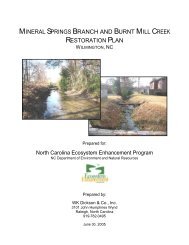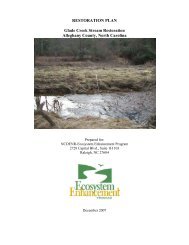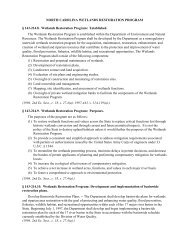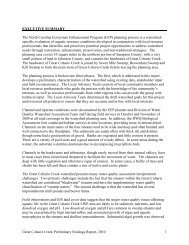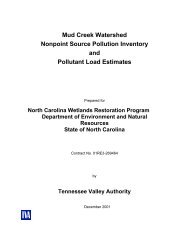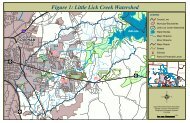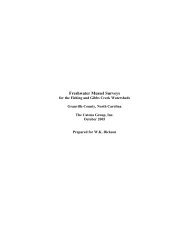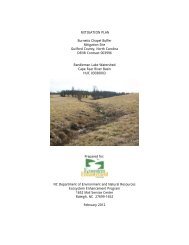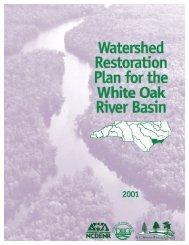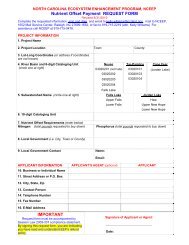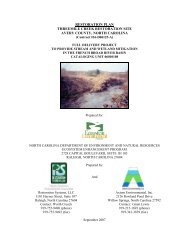Mud Creek Watershed Restoration Plan - Henderson County Center
Mud Creek Watershed Restoration Plan - Henderson County Center
Mud Creek Watershed Restoration Plan - Henderson County Center
Create successful ePaper yourself
Turn your PDF publications into a flip-book with our unique Google optimized e-Paper software.
Chemical Water Quality Sampling: In addition to biological sampling, WARP also conductedextensive chemical water quality sampling to characterize water quality conditions in thewatershed and to evaluate whether chemical and physical conditions might be negativelyaffecting benthic communities. WARP established five sampling stations at the downstreamends of the subwatersheds and evaluated these sites monthly for a standard set of parametersincluding pH, dissolved oxygen, temperature, metals, turbidity, and nutrients. Samples werecollected during both baseflow and stormflow periods. WARP also collected grab samples at anumber of sites in the watershed with known biological impairment. The purpose of the grabsamples was to assess potential chemical stressors such as pesticides, hydrocarbons and volatileorganic pollutants. Figure 2. 9 illustrates the location of WARP water quality sampling sitesacross the <strong>Mud</strong> <strong>Creek</strong> watershed.WARP chemical water qualitymonitoring data indicated thatmany streams in the <strong>Mud</strong><strong>Creek</strong> watershed includingupper and lower <strong>Mud</strong> <strong>Creek</strong>,Clear <strong>Creek</strong>, Devils Fork, andBat Fork have higher nutrientand specific conductancelevels than expected forunpolluted streams in themountains. However, theselevels were not high enough toaffect biological communitiesor exceed NC’s standard oraction levels. Dissolvedoxygen levels in these streamswere adequate for aquatic life.In upper <strong>Mud</strong> <strong>Creek</strong> and BatFork, fecal coliform bacterialevels were above the NCstandards of 200colonies/100mL. Althoughfecal coliform does not affectbiological communities, it canindicate the presence of virusesand pathogens that pose a riskto human health.Figure 2.8: Location of WARPwater chemistry sampling sites.Water samples taken during storms in the Clear <strong>Creek</strong> watershed had levels of insecticides thatare above ecological screening benchmarks and may cause sub-lethal impacts to aquatic insects.Bed sediment samples collected from upper <strong>Mud</strong> <strong>Creek</strong> and Clear <strong>Creek</strong> provided evidence ofboth current and past use pesticide inputs. WARP identified pesticides as a cause of biologicalimpairment in these streams.Section 2: <strong>Watershed</strong> Characterization Page 14




